Fez is, I think, my favorite video game. I’ve beaten it to completion a small handful of times, and I’m always mournful when the whole map is gold, because that means I’m out of content. But there are a couple nagging, unsolved mysteries in Fez. This post is a summary of what we know, and what we know we don’t know, about the endgame and post-endgame of Fez.
It goes without saying that this post is full of spoilers. In fact, it contains nothing but spoilers. If you haven’t beaten Fez, there’s nothing for you here. But it’s a three-year-old game, so I think the statute of limitations has passed. Below you’ll find a discussion of some of the larger mysteries of Fez, both solved and unsolved.
If there’s something you think I missed or got wrong, I’d love to hear from you in the comments below.
The Heart Cube Conspiracy
The Language
Fez has English dialog coded with a simple cypher. It is clearly intended, but optional, for most users to be able to decode this language. There is even a stone block reading (in code) “The quick brown fox jumps over the lazy dog” in front of a languorous canine being leapfrogged by Vulpes vulpes.
It turns out that the language is completely superfluous except for one puzzle. You can complete every puzzle in the game, save one, without decoding the language. In fact, I never decoded any of the dialog in any of my playthroughs. Transliterating just isn’t my idea of fun. The puzzle that requires language skills is known as the “security room” puzzle.
In the security room, there’s a floating rectangular prism which has two messages. The first reads
PLEASE ANSWER THIS SECURITY QUESTION WHATS MY NAME
The second reads
SECURITY QUESTION HINT MY FIRST HALF IS WHAT IT IS MY SECOND HALF IS HALF OF WHAT MADE IT
Then, there’s a jumble of random letters on blocks below.
The answer is given as a concatenation of “meta” and “tron.” Meta is data about data, or “is what it is.” “Tron” is the second half of the name of the company which made Fez: Polytron. And indeed, that’s almost certainly the correct way to come to this conclusion.
There’s a handful of Christian and Judaic hints in this solution and in the tome’s translation, but they don’t mean much to me. I shy away from numerological answers, since they can lead anywhere you want to, so I feel those fit more into the “flavor” category than into the “puzzle hint” category.
The Monolith
The monolith was probably the first major Fez mystery. There is a treasure map in the game which is burnt in half. The half you find has a button combo code on it, and an indication of where to stand in an otherwise empty room. After you enter that code while standing in the center of one of two circles, a black rectangular prism floats up out of the ground and spins while hanging in mid-air. There is no indication of what to do next.
Some intuition leads one to conclude that you should stand in the other circle and enter some other code. But what code? That’s our first still-unsolved mystery: how do we find this code? People have brute forced it. In fact, it was kind of a fun community effort back when the game first came out.
But brute forcing the solution feels wrong. One could brute force all of the codes in the game, but there are always solutions derived from game logic. Is brute forcing really the correct method for this one? Far more satisfying would be a concrete and obviously correct solution derived from clues found within the game, or from its real world paraphernalia.
There’s lots of guesses for how we were intended to discover this code. The popular one is some crazy derivation of the release date, though that’s got a few holes in it. Maybe some “black box” transformation function? No one knows.
The trouble is all these “solutions” seem like they’re working backwards. There’s no way to know which solution, if any, is the intended solution to this puzzle. In fact, maybe brute forcing was the correct solution after all! Poke the black box with enough inputs until something pops out. All these proposed solutions might be backwards justifications for a puzzle that never existed. There’s no way to know without finding another hint, or some feedback from Polytron. For the time being, it remains unsolved, three years after the game’s initial release.
The Observatory
This is a fun one, and it has the benefit of being solved. There’s an observatory with a telescope in the late game of Fez. You can view the stars at nighttime through this telescope. There’s the usual tetromino-based puzzle, but solving it won’t turn the room gold on the map. There’s something more.
Through the telescope, you can find two blinking, red dots, one to the bottom-left and one to the upper-right. If you record them, these actually spell out a 96-bit piece of data. Split that into bytes and decode into 8-bit ASCII and you end up with a sequence of L and R characters that spell out a code. Brilliant and incredibly hard to solve… except there’s a mistake. If you just tap left and right in time with the red lights as they blink, you’ll end up solving it anyway due to a substring of the bits matching the same L and R sequence. Whoops.
The Heart Room
So, what prize do these three difficult puzzles result in? For each, a Red Heart Cube. Your companion, Dot, acknowledges the first heart cube you receive with a bewildered reaction. What on Earth is this thing for?
After solving all of the other puzzles in the game and receiving 64 cubes, you finally open a door accessible fairly early on in the game. This leads to the Heart Room, where your three Heart Cubes assemble to form a pretty heart.
This heart is actually the logo of an indie gaming collective that Fez’s designer, Phil Fish, was a part of. Just a little Easter egg for diehard fans? Yes, but…
The Heart Disintegration Codes
This is where the mysteries kick into high gear. After a while, Fez was eventually released for the PC, which opens up all sorts of hacking avenues. People have long since reverse-engineered the game’s data formats and begun data-mining the game for anything that hasn’t yet been discovered.
There are two artifacts in the game that are designed to give you hints towards the language and number systems in the game. These are referred to as the letters cube and the numbers cube, as they show you how to draw each letter and each number. You can look at and rotate these items in your inventory. Through reverse engineering, one player found codes for each artifact that can be entered only while standing in the Heart Room. You look at each artifact, enter a certain sequence of L and R button presses, and then…
the heart dissolves into space.
What does this mean? How were we supposed to find these codes? Significantly, they’re the only codes in the entire game that are entered in the menu screens.
One theory, my favorite, is that discovering these codes is only possible through reverse engineering. By entering these codes, that means that you must have broken apart the game to examine its insides, and you have effectively “broken the developer’s heart” by tearing into the game’s internals. You’re cheating. Your reward is an empty room after the heart breaks to pieces and disappears. Jerk.
There is one small piece of supporting evidence for this theory. Entering the code on the original, Xbox 360 release will break your save game. This looks to me like an unfinished piece of the game. The functionality is still present, but there is no way to discover the code except by reverse engineering. Perhaps they forgot to playtest this non-feature while trying to fix some of the notorious save-game bugs, leading to the corruption observed by players who enter this “unofficial” code.
There are other theories. Crazy numerology? Something to do with stereoscopic mode? Just like the monolith code, no one knows, and it’s impossible to know without further data. Another unsolvable mystery.
The Classroom Numbers
There’s a significant room in the game where the number system is spelled out. The mystery here is a long set of digits present in that very classroom, which have no use in or out of the game, to anyone’s knowledge.
The numbers are transcribed as:
2 4 2 5 3 6 4 1 5 4 4 4 3 3 3 6 5
Most text in Fez is read top-to-bottom-right-to-left, so something like “45 614436” and “223 454335”.
Numbers in Fez work strangely. There are multiple representations for the same digit. The number four can be represented with both a single line to the left (“four”) or with two lines, one up (“one”) and one down (“plus three”). This is straightforward enough. After a little practice it’s easy to read any number the game gives you, and you never need to write your own. Perhaps significantly, the number four is written in both manners in this snippet. Maybe it’s just gibberish for you to practice reading numbers? Maybe it’s a secret hint at the monolith code? Perhaps you can somehow derive the heart disintegration codes from these sigils? Letter coordinates to some unknown corpus? A café in Montreal?
Lesser Mysteries?
The above is, in my opinion, a complete list of mysteries remaining in Fez. I think these are all questions to which an answer exists that we don’t have.
Below are some more gray area, open ended questions. In my opinion, they’re dead ends. Leftover artifacts from unused puzzles, or just design elements that people are reading too much into.
The Soundtrack Images
Fez’s outstanding music was written by Disasterpeace. Downloading the soundtrack and running it through a spectrogram analysis (a visual representation of audio frequencies across time) yields images. As far as I can tell, no one has gotten anywhere with these. You can find some descriptions of what is represented in the image, but there’s no real hook back into the game. Neil Armstrong? Harry Truman? Huh?
I think there might be something here, but I think it’s just too esoteric. It’s just too open-ended to come up with any interesting conclusions. Any guess is just that: a guess. There’s nowhere to go, here. It’s a dead end without any more info.
The Tome
One of the artifacts you acquire in the game, along side the letter and number cubes, is a book. It’s a long book, written in Fez’s cypher language, and worse, it’s scrambled. It can be unscrambled (see the Ars Technica article linked above for the process), but doesn’t really yield anything interesting. The “release date theory” of the monolith code depends on the unscrambling order, but as I described, I don’t really buy that theory.
Is the tome just a bit of incredibly hard to find flavor text? That’s my guess.
One larger problem is the letters written on the back (verso) of each page. From the front of the book to the back, these spell out PAEAEBUB. Huh? Repeated letters mean they’re not “page numbers” of any sort. So… what are they?
The Skull
The final artifact you get is an ancient skull from a precursor to the current civilization. This skull has no use in the game whatsoever. The skull shape is referenced a couple times, in the ancient civilization areas, and, oddly, in the boiler room in the first village. But… then what? Reverse engineering has turned up nothing to do with the skull. Is it just flavor? I guess so…
Concentric Rings
Scattered throughout the game are flat textures depicting concentric, white rings. There’s one image containing one ring, one containing two rings, and so on up to eight rings. All of these rings are written on the floor and can only be seen in first-person mode. One cannot be seen inside the game, ever. This one is on the Fractal stage in the forest, the only room where the rotation mechanism is locked by the rotating totem in the center of the stage. First-person mode doesn’t work here, so you can’t see the rings on the floor.
Is there something here? Maybe, but I can’t imagine what. The fact that one of them isn’t even viewable makes me think it’s just a design pattern, or possibly a leftover from a half-baked puzzle. Nothing significant, in my opinion.
So Now What?
To the best of my knowledge, these are all of the significant loose ends in Fez. In my opinion, we won’t find any obviously correct solutions to any of the mysteries presented above. At best we can rank our guesses in order of plausibility. It’s a bit unsatisfying, in my opinion. So much thought was put into the puzzles in this game, that it tears at me that we have puzzles whose solutions we’ll never know. I feel like there’s more we can discover here, but it just hasn’t been laid out in a way that is intelligible. I think the only way we’ll be able to definitively put these to rest is if someone in a position of authority gives us nudges in the right direction, or tells us if we’re barking up the wrong trees.
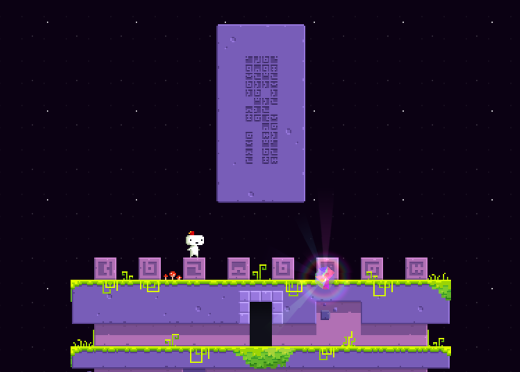
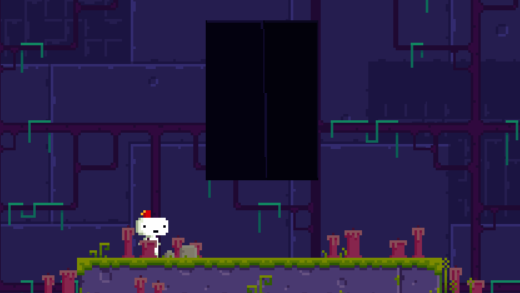
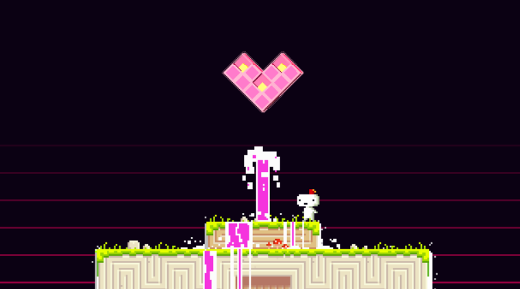
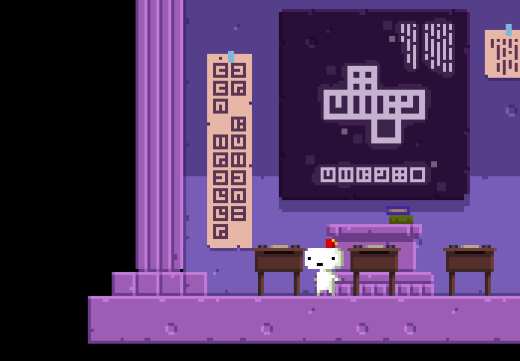
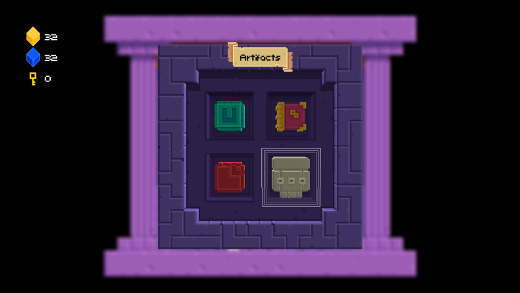
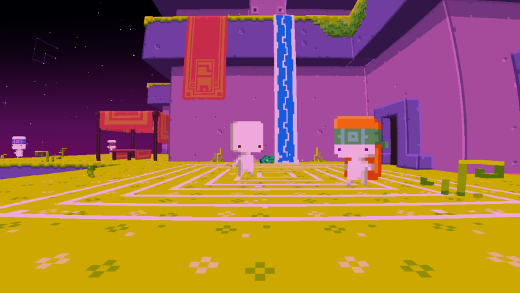
Nice article. I think that observatory puzzle is just pressing L and R when the stars blink, it’s not a bug, someone ovethinked it by decodong it to binary numbers and ASCII, I smiled when I saw that approach.
Great review Fez’ loose ends!
But I also have some doubts about the game…I’ve been reading all types of theories on forums, but it seems that nobody give any attention to some facts that look important to me…
For example the 4-cube world in which we cannot use LT or RT and there is also big concentric rings on the floor…
Another point is, it seems like everytime the Hexahedron “gives” you a new resource (like the fez we receive on the beginning of the game, or the POV glasses), this resource is used to discover new secrets (like rotating perspective, or being able to see the concentric circles on the floor).
My question is: the stereoscopic glass shouldn’t be used for something?
Well…these are some doubts that I had…
Thanks for the article!
The skull is not from the previous Zuish (or so-called “Big Head”) generation, the skull is from the aliens. Reference the number of eyes and the three sockets at the base of it. This is why Dot remarks in awe, “So they DID visit here” or whatever it says exactly.